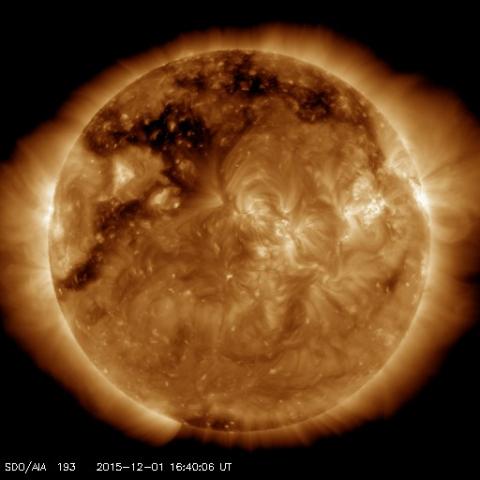What is the climate waiting for Russia and Europe in 15-20 years? Will be there weather abnormalities in the coming decades? Will some areas experience more severe winter, while the others will have hot summer? It all depends on how much the climate will be affected by the dynamics of the possible onset of minimum solar magnetic activity. The Sun's behaviour in future cycles is the main theme of a publication on the forecast and explanation of the minima of solar activity. The paper was prepared with contributions from Elena Popova from the Skobeltsyn Institute of Nuclear Physics (Lomonosov Moscow State University) and was published in Scientific Reports.
Scientists have studied the evolution of the solar magnetic field and the number of sunspots on the Sun's surface. The amplitude and the spatial configuration of the magnetic field of our star are changing over the years. Every 11 years the number of sunspots decreases sharply. Every 90 years this reduction (when it coincides with the 11-year cycle) reduces the number of spots by about a half. A 300-400 year lows reduce their numbers almost to zero. Best known minimum is the Maunder minimum, which lasted roughly from 1645 to 1715. During this period, there were about 50 sunspots instead of the usual 40 000-50 000.
Analysis of solar radiation showed that its highs and lows almost coincide with the maxima and minima in the number of spots. By studying changes in the number of sunspots, analyzing the content of isotopes like carbon-14, beryllium-10, and others, in glaciers and trees, the researchers concluded that the solar magnetic activity has a cyclic structure.
A group of scientists - Valentina Tarasova (Northumbria University, England, Space Research Institute, Ukraine), Elena Popova (SINP, MSU), Simon John Shepherd (University of Bradford, England) and Sergei Zharkov (University of Hull, England) - analyzed three solar activity cycles from 1976 to 2009, using the so-called "principal component analysis", which allows reveal waves of solar magnetic field with the biggest contribution in the observational data. As a result of a new method of analysis, it was found that the magnetic waves in the Sun are generated in pairs, and the main pair is responsible for changes in the dipole field, which is observed when solar activity is changing. Also scientists have managed to obtain analytical formulas describing the evolution of both waves.
Using empirically found two waves of the magnetic field, Elena Popova hypothesized that the minima of solar magnetic activity can be caused by the process of the beating of these two waves. Each wave is generated at different depths in the Sun and the waves have similar frequencies. As a result of ascent of the magnetic field on the surface the waves begin to interact which ends in beating of amplitude of the resulting magnetic field. This leads to a significant decline in the amplitude of the magnetic field for several decades. Comparison of the results of the model was carried out both with an array of observed magnetic field data for cycles 21-23, and with the observed data of solar activity over 1000 years. On this scale the model calculations of Popova were very close to the characteristics of solar magnetic activity.
By highlighting the indicative period of the beats (which is about a few centuries), scientists have reconstructed solar activity since ancient times (starting from the year 1200) and predicted it until the year 3200. The given chart shows that solar activity decreases dramatically about every 350 years. And upcoming decrease in solar activity begins nowadays.
Will all this affect the weather on Earth?
"Studies have shown that over the last 400 000 years there were 5 global warming and 4 ice ages. What caused them? How much can solar activity affect the weather and climate change? This question is still not solved and is extremely relevant and interesting challenge for the various researchers around the world. There are a number of theories that suggest very different degrees of influence of solar activity on weather and climate. In addition to solar activity, climatologists offer other factors that may affect the dynamics of Earth's climate system. Such a system is a very complex nonlinear system, and further use of numerical simulation and analysis of paleodata can help in the investigation", says Elena Popova. "If in the near future there would be a minimum of solar activity, it would give an opportunity to see what happens with the climate dynamics and test existing theories about the influence of solar activity. Actually, even if we start from the simple knowledge of the cyclicality of the Sun, it can be said that it's already time for hundred-year-minima - the previous one has happened in the beginning of XX century. Of course, it is necessary to take into account the effect of other factors and processes in the atmosphere; however, the challenges have always intrigued scientists".


